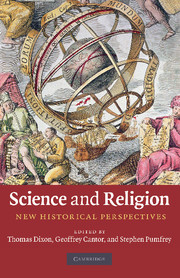Book contents
- Frontmatter
- Contents
- List of contributors
- Preface
- 1 Introduction
- PART I CATEGORIES
- 2 ‘Science’ and ‘religion’: constructing the boundaries
- 3 Science and religion in postmodern perspective: the case of Bruno Latour
- PART II NARRATIVES
- PART III EVOLUTION AND CREATIONISM
- PART IV THE POLITICS OF PUBLISHING
- PART V WAYS FORWARD
- Select bibliography
- Index
2 - ‘Science’ and ‘religion’: constructing the boundaries
Published online by Cambridge University Press: 05 May 2010
- Frontmatter
- Contents
- List of contributors
- Preface
- 1 Introduction
- PART I CATEGORIES
- 2 ‘Science’ and ‘religion’: constructing the boundaries
- 3 Science and religion in postmodern perspective: the case of Bruno Latour
- PART II NARRATIVES
- PART III EVOLUTION AND CREATIONISM
- PART IV THE POLITICS OF PUBLISHING
- PART V WAYS FORWARD
- Select bibliography
- Index
Summary
Over the past decade a number of historians of science have expressed strong reservations about whether their particular subject of interest actually has much of a history. Science, as the discipline is currently understood, emerged only during the nineteenth century, they tell us. Prior to that, students of nature had thought of themselves as pursuing ‘natural philosophy’ or ‘natural history’ – disciplines with a somewhat different orientation from that of twenty-first-century science. This claim has obvious ramifications for those whose concern lies with the past relationship between science and religion, for, if true, such a relationship cannot be older than the nineteenth century. Similar historical sensitivities are evident in the sphere of religious studies, in which increasing numbers of scholars have suggested that the idea ‘religion’, like ‘science’, is a modern development. ‘Religion’, and the plural ‘religions’, it is claimed, did not begin to take on their present meanings until the seventeenth century. The notion that there are ‘religions’, distinguished by discrete sets of beliefs and practices and linked by a common and generic ‘religion’, is actually a product of the European Enlightenment. During that period, the acute need to arrive at some criterion to adjudicate between different faiths led to the construction of ‘religions’ as sets of propositional beliefs that could be impartially compared and judged.
In this chapter I shall explore in some detail the historical circumstances of the emergence of the dual categories ‘science’ and ‘religion’ with a view to showing their direct relevance for contemporary discussions of the science–religion relation.
- Type
- Chapter
- Information
- Science and ReligionNew Historical Perspectives, pp. 23 - 49Publisher: Cambridge University PressPrint publication year: 2010
- 9
- Cited by



